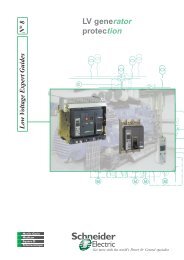sepam 20 user manual - Schneider Electric
sepam 20 user manual - Schneider Electric
sepam 20 user manual - Schneider Electric
You also want an ePaper? Increase the reach of your titles
YUMPU automatically turns print PDFs into web optimized ePapers that Google loves.
4<br />
DE80251<br />
DE80252<br />
DE80253<br />
Control and monitoring<br />
functions<br />
Relay output<br />
Watchdog<br />
Permanent internal failure.<br />
Relay output<br />
Watchdog<br />
Transient internal failure.<br />
Relay output<br />
Watchdog<br />
Repeated transient internal failures.<br />
4/18<br />
5 to 7 seconds<br />
Counter 0 1 2 0 1 2 3 4 5<br />
Sepam<br />
de-energized<br />
Self-tests and fail-safe position<br />
Fail-safe position<br />
When Sepam is in working order, it runs self-tests continuously. Detection of a major<br />
failure places Sepam in the fail-safe position.<br />
State of Sepam in the fail-safe position<br />
b All the output relays are forced to the idle state<br />
b All protection functions are inhibited<br />
b The watchdog output indicates failure (output in the idle state)<br />
b A red LED on the Sepam front panel is on and a diagnostic message appears on<br />
the Sepam display unit (see “Indications” page 4/13).<br />
How Sepam deals with failures<br />
b Minor failure: Sepam switches to downgraded operation.<br />
The failure is indicated on the Sepam display unit and also by the communication.<br />
Sepam continues to protect the installation.<br />
b Major failure: Sepam switches to the fail-safe position and attempts a restart during<br />
which it again runs its self-tests. There are 2 possible scenarios:<br />
v The internal failure is still present. It is a permanent failure. Intervention on Sepam<br />
is required. Only removing the cause of the failure, followed by de-energizing and<br />
then energizing Sepam, will allow the unit to exit the fail-safe position.<br />
v The internal failure is no longer present. It is a transient failure. Sepam restarts so<br />
that it can continue to protect the installation. Sepam has been in the fail-safe position<br />
for 5 to 7 s.<br />
Limiting the number of transient failure detections<br />
Each time a transient internal failure appears, Sepam increments an internal counter.<br />
The fifth time the failure occurs, Sepam is placed in the fail-safe position. Deenergizing<br />
Sepam reinitializes the failure counter. This mechanism can be used to<br />
avoid keeping a Sepam running that is subject to repeated transient failures.<br />
PCRED301005EN - 06/<strong>20</strong>08

















